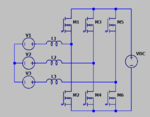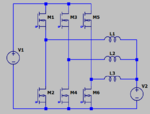
- Joined
- Jan 22, 2008
- Messages
- 53,691
- Helped
- 14,811
- Reputation
- 29,919
- Reaction score
- 14,437
- Trophy points
- 1,393
- Location
- Bochum, Germany
- Activity points
- 303,551
I don't see how energy can be picked up by a capacitor in a hard switching push-pull configuration. Coss is always charged from Vdc through MOSFET and discharged by MOSFET. I don't recognize a sign error below.When one capacitor is discharging, the same energy is being picked up by the other one, of course, if capacitors were linear.
Code:
Esw,tot = Esw1 + Esw2
= ∫Coss(V) V dV + ∫Coss(V)(Vdc - V) dV
= ∫Coss(V) Vdc dV
= avg(Coss(V) Vdc²or referring to the datasheet quantities Co(er) and Co(tr)
Code:
Esw,tot = Esw1 + Esw2
= 0.5 Co(er) Vdc² +
(Co(tr) - 0.5 Co(er)) Vdc²
= Co(tr) Vdc²




